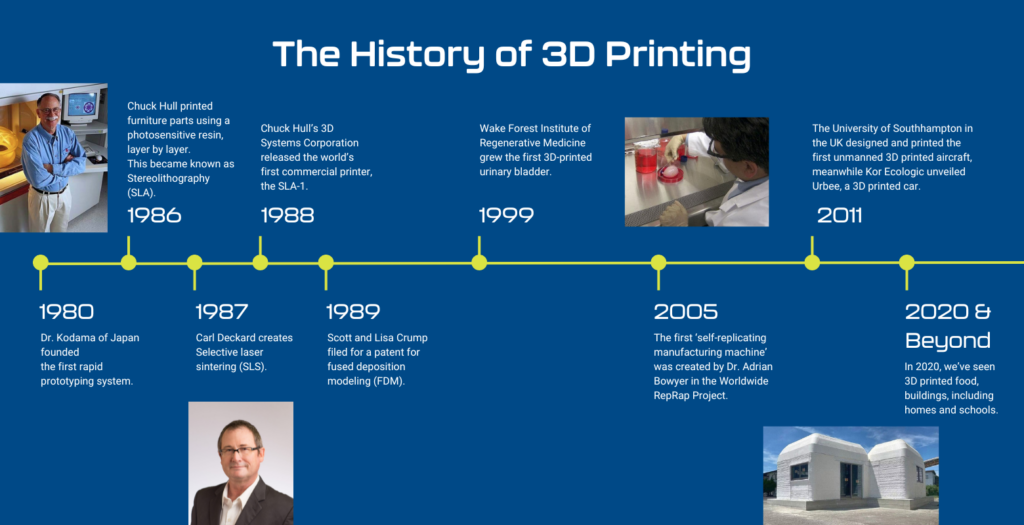Happy International 3D Printing Day!
3D printing has come a long way since the first milestone in the 1980s, and while it may not be as mainstream as your 2D home printer, we’re using more and more 3D-printed products daily! To celebrate today, and all the advancements made to 3D printing, we’re looking back at the journey and some of the milestones over the past four decades.
1980 – The first 3D print technology is founded
Dr. Kodama of Japan founded the first rapid prototyping system, which used UV light to polymerize a photosensitive resin. Unfortunately, he was unable to create a patent for 3D printing.
1986 – Chuck Hull Patented Stereolithography and Founded 3D Systems, Inc.
Charles (Chuck) Hull needed a tiny custom part made quickly for the furniture he manufactured, so he built a 3D printer that printed the photosensitive resin layer by layer. This became known as Stereolithography (SLA), when Hull filed the patent.
1987 – SLS became the second 3D print technology to be founded
Selective Laser Sintering (SLS) became the second 3D print technology to be created by Carl Deckard.
Deckard developed the technology during summer camp where he was working at an iron-based machine shop in Houston. The first SLS machine, nicknamed Betsy, fuses small particles of plastic, metal, ceramic, or glass powders into solid 3D forms with a high-powered laser.
1988 – The first 3D printer is sold
Chuck Hull’s 3D Systems Corporation released the world’s first commercial printer, the SLA-1.
1989 – Stratasys, Inc is founded
Scott and Lisa Crump filed for a patent for fused deposition modeling (FDM) after Scott decided to make a toy frog for their daughter using a glue gun loaded with a mixture of polyethylene and candle wax.
Scott would later co-found Stratasys, Inc.
1999 – The first 3D-printed organ
Wake Forest Institute of Regenerative Medicine grew the first 3D-printed urinary bladder for transplant surgery. They coated the organ with cells from the patient, so the body was unlikely to reject the 3D-printed bladder.
2005 – The RepRap Project
The first ‘self-replicating manufacturing machine’ was created by Dr. Adrian Bowyer in the Worldwide RepRap Project. Bowyer was later awarded an MBE in the UK’s New Year Honours.
2011 – 3D printed aircrafts and cars
The University of Southampton in the UK designed and printed the first unmanned 3D printed aircraft, meanwhile Kor Ecologic unveiled Urbee, a prototype car with a 3D printed body.
2020 & beyond – What about the future?
3D printing is helping to revolutionize sectors such as transportation, architecture, and medical. We’ve already seen 3D-printed organs and prosthetics, and we could see 3D printing help solve the lack of donors to give fast life-saving solutions.
There have been a few opportunities already for 3D-printed buildings, such as 3D-printed homes that could help create a solution for affordable housing. In 2022, the non-profit technology start-up TEAM4UA also began looking at the opportunity to build 3D-printed schools in the Ukraine to replace buildings that have been destroyed.
NASA has also been utilizing 3D printing for astronauts’ food sources while they are in space, which could also help to better the management of the Earth’s resources and increase sustainability efforts.
It’s safe to say there is no shortage of possibilities for what 3D printing can do!

